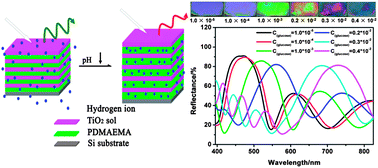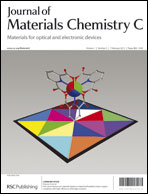Biochemical-to-optical signal transduction by pH sensitive organic–inorganic hybrid Bragg stacks with a full color display
Abstract
A synthetic route to attain environment-sensitive thin-film Bragg stacks (BSs) that behave as a kind of visual signal transducer is shown. Herein, organic–inorganic hybrid BSs are fabricated by alternating thin layers of poly(N,N′-dimethylaminoethyl methacrylate) (PDMAEMA) and titanium dioxide through spin-coating, a facile, reproducible and cost-efficient approach. The BSs display bright non-bleaching structural color over the entire visible region, which arises from periodic modulation of the refractive index. Tailoring of optical properties is achieved by regulation of slab periodicity and/or introduction of planar defects. Since alteration of hydrogen ion concentration can cause the swelling transition of the responsive polymeric layer, PDMAEMA, color changes of the as-prepared BSs could be initiated by different pH values of aqueous media. Therefore, transformation of chemical signals into optical effects is obtained for analytical applications. The platform furnishes us an opportunity to realize biochemical-to-optical signal transduction by coupling it with a highly specific enzymatic reaction, glucose oxidation reaction catalyzed by the enzyme glucose oxidase. A dramatic photonic bandgap shift, more than 200 nm, makes it direct and convenient to differentiate the reflective color using the naked eyes. Besides, the intriguing characteristics make the Bragg stacks eminently suitable for other applications, such as environmental monitoring and medical diagnostics.


 Please wait while we load your content...
Please wait while we load your content...